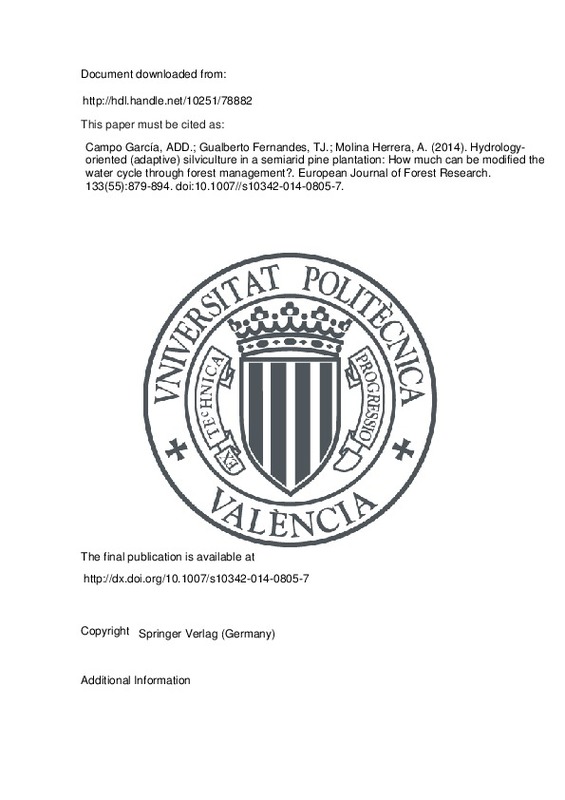JavaScript is disabled for your browser. Some features of this site may not work without it.
Buscar en RiuNet
Listar
Mi cuenta
Estadísticas
Ayuda RiuNet
Admin. UPV
Hydrology-oriented (adaptive) silviculture in a semiarid pine plantation: How much can be modified the water cycle through forest management?
Mostrar el registro sencillo del ítem
Ficheros en el ítem
| dc.contributor.author | Campo García, Antonio Dámaso del
|
es_ES |
| dc.contributor.author | Gualberto Fernandes, Tarcisio Jose
|
es_ES |
| dc.contributor.author | MOLINA HERRERA, ANTONIO
|
es_ES |
| dc.coverage.spatial | east=-1.0574163999999655; north=39.05978899999999; name=46620 Aiora, València, Espanya | es_ES |
| dc.date.accessioned | 2017-03-21T10:19:46Z | |
| dc.date.available | 2017-03-21T10:19:46Z | |
| dc.date.issued | 2014-09 | |
| dc.identifier.issn | 1612-4669 | |
| dc.identifier.uri | http://hdl.handle.net/10251/78882 | |
| dc.description.abstract | [EN] Hydrology-oriented silviculture might adapt Mediterranean forests to climatic changes, although its implementation demands a better understanding and quantification on the water fluxes. The influence of thinning intensity (high, medium, low and a control) and its effect on the mid-term (thinned plots in 1998 and 2008) on the water cycle (transpiration, soil water and interception) and growth [basal area increment (BAI)] were investigated in 55-year-old Aleppo pine trees. Thinning enhanced a lower dependence of growth on climate fluctuations. The high-intensity treatment showed significant increases in the mean annual BAI (from 4.1 to 17.3 cm(2)) that was maintained in the mid-term. Thinning intensity progressively increased the sap flow velocity (v (s)) in all cases with respect to the control. In the mid-term, an increased functionality of the inner sapwood was also observed. Mean daily tree water use ranged from 5 (control) to 18 (high intensity) l tree(-1). However, when expressed on an area basis, daily transpiration ranged from 0.18 (medium) to 0.30 mm (control), meaning that in spite of the higher transpiration rates in the remaining trees, stand transpiration was reduced with thinning. Deep infiltration of water was also enhanced with thinning (about 30 % of rainfall) and did not compete with transpiration, as both presented opposite seasonal patterns. The changes in the stand water relationships after 10 years were well explained by the forest cover metric. The blue to green water ratio changed from 0.15 in the control to 0.72 in the high-intensity treatment, with the remaining treatments in the 0.34-0.48 range. | es_ES |
| dc.description.sponsorship | This study is a component of two research projects: ‘‘CGL2011-28776-C02-02, Hydrological characterisation of forest structures at plot scale for an adaptive management, HYDROSIL’’, funded by the Spanish Ministry of Science and Innovation and FEDER funds, and ‘‘Determination of hydrological and forest recovery factors in Mediterranean forests and their social perception’’, led by Dr. E. Rojas and supported by the Ministry of Environment, Rural and Marine Affairs. The authors are grateful to the Valencia Regional Government (CMAAUV, Generalitat Valenciana) and the VAERSA staff for their support in allowing the use of the La Hunde experimental forest and for their assistance in carrying out the fieldwork. The second author thanks the Mundus 17 Program, coordinated by the University of Porto—Portugal. | |
| dc.language | Inglés | es_ES |
| dc.publisher | Springer Verlag (Germany) | es_ES |
| dc.relation.ispartof | European Journal of Forest Research | es_ES |
| dc.rights | Reserva de todos los derechos | es_ES |
| dc.subject | Blue-green water | es_ES |
| dc.subject | Dendrochronology | es_ES |
| dc.subject | Forest hydrology | es_ES |
| dc.subject | Pinus halepensis | es_ES |
| dc.subject | Transpiration | es_ES |
| dc.subject.classification | INGENIERIA HIDRAULICA | es_ES |
| dc.subject.classification | TECNOLOGIA DEL MEDIO AMBIENTE | es_ES |
| dc.title | Hydrology-oriented (adaptive) silviculture in a semiarid pine plantation: How much can be modified the water cycle through forest management? | es_ES |
| dc.type | Artículo | es_ES |
| dc.identifier.doi | 10.1007//s10342-014-0805-7 | |
| dc.relation.projectID | info:eu-repo/grantAgreement/MICINN//CGL2011-28776-C02-02/ES/CARACTERIZACION HIDROLOGICA DE LA ESTRUCTURA FORESTAL A ESCALA PARCELA PARA LA IMPLEMENTACION DE SILVICULTURA ADAPTATIVA/ | es_ES |
| dc.rights.accessRights | Abierto | es_ES |
| dc.contributor.affiliation | Universitat Politècnica de València. Escuela Técnica Superior de Ingeniería Agronómica y del Medio Natural - Escola Tècnica Superior d'Enginyeria Agronòmica i del Medi Natural | es_ES |
| dc.description.bibliographicCitation | Campo García, ADD.; Gualberto Fernandes, TJ.; Molina Herrera, A. (2014). Hydrology-oriented (adaptive) silviculture in a semiarid pine plantation: How much can be modified the water cycle through forest management?. European Journal of Forest Research. 133(55):879-894. https://doi.org/10.1007//s10342-014-0805-7 | es_ES |
| dc.description.accrualMethod | S | es_ES |
| dc.relation.publisherversion | http://dx.doi.org/10.1007/s10342-014-0805-7 | es_ES |
| dc.description.upvformatpinicio | 879 | es_ES |
| dc.description.upvformatpfin | 894 | es_ES |
| dc.type.version | info:eu-repo/semantics/publishedVersion | es_ES |
| dc.description.volume | 133 | es_ES |
| dc.description.issue | 55 | es_ES |
| dc.relation.senia | 284724 | es_ES |
| dc.identifier.eissn | 1612-4677 | |
| dc.contributor.funder | Ministerio de Ciencia e Innovación |







![[Cerrado]](/themes/UPV/images/candado.png)

